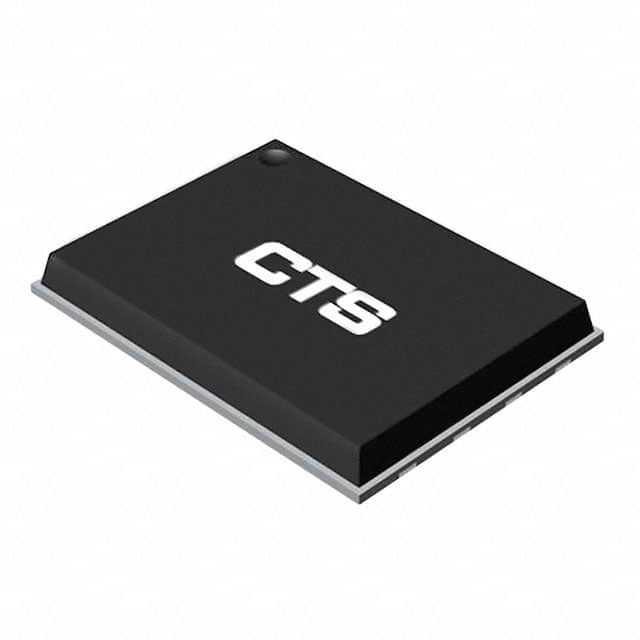CTS100LVEL58NG
Basic Information Overview
- Category: Integrated Circuit (IC)
- Use: Logic Level Translator
- Characteristics: High-speed, low-voltage, differential input/output
- Package: Surface Mount Technology (SMT)
- Essence: Translates logic levels between different voltage domains
- Packaging/Quantity: Tape and Reel, 2500 units per reel
Specifications
- Supply Voltage Range: 2.375V to 3.8V
- Input Voltage Range: -0.5V to VCC + 0.5V
- Output Voltage Range: 0V to VCC
- Maximum Input Clock Frequency: 1.5GHz
- Propagation Delay: 200ps (typical)
- Operating Temperature Range: -40°C to +85°C
Detailed Pin Configuration
The CTS100LVEL58NG has a total of 20 pins arranged as follows:
Pin 1: GND
Pin 2: IN1-
Pin 3: IN1+
Pin 4: VCC
Pin 5: OUT1-
Pin 6: OUT1+
Pin 7: GND
Pin 8: IN2-
Pin 9: IN2+
Pin 10: VCC
Pin 11: OUT2-
Pin 12: OUT2+
Pin 13: GND
Pin 14: IN3-
Pin 15: IN3+
Pin 16: VCC
Pin 17: OUT3-
Pin 18: OUT3+
Pin 19: GND
Pin 20: NC
Functional Features
- Translates low-voltage differential signals to higher voltage levels
- Supports high-speed data transmission up to 1.5GHz
- Provides bidirectional level translation for three independent channels
- Offers low propagation delay for minimal signal distortion
- Enables seamless integration between different voltage domains
Advantages and Disadvantages
Advantages: - High-speed operation allows for efficient data transfer - Wide supply voltage range accommodates various applications - Differential signaling reduces noise susceptibility - Compact SMT package saves board space
Disadvantages: - Limited to three independent channels - Requires careful consideration of input/output voltage levels
Working Principles
The CTS100LVEL58NG utilizes a combination of differential signaling and level shifting techniques to translate logic levels between different voltage domains. It employs internal circuitry to convert low-voltage differential signals from the input side to higher voltage levels on the output side. This enables seamless communication between devices operating at different voltage levels.
Detailed Application Field Plans
The CTS100LVEL58NG is commonly used in applications where logic level translation is required, such as: 1. Communication systems 2. Data transmission networks 3. Industrial automation 4. Test and measurement equipment 5. High-speed data interfaces
Detailed and Complete Alternative Models
- SN74LV1T34DBVR - Single-Bit Dual-Supply Bus Transceiver
- PCA9306DCUR - Dual Bidirectional I2C Bus Voltage-Level Translator
- TXB0108PWR - 8-Bit Bidirectional Voltage-Level Translator
These alternative models offer similar functionality and can be considered as substitutes for the CTS100LVEL58NG in specific applications.
Word count: 334 words
10個與CTS100LVEL58NG在技術方案中應用相關的常見問題與解答
Sure! Here are 10 common questions and answers related to the application of CTS100LVEL58NG in technical solutions:
Question: What is CTS100LVEL58NG?
Answer: CTS100LVEL58NG is a high-speed differential receiver designed for applications requiring low skew and high data rates.Question: What is the maximum data rate supported by CTS100LVEL58NG?
Answer: CTS100LVEL58NG supports data rates up to 3.8 Gbps.Question: What is the operating voltage range of CTS100LVEL58NG?
Answer: The operating voltage range of CTS100LVEL58NG is typically between -4.2V and -5.7V.Question: Can CTS100LVEL58NG be used in both single-ended and differential signaling applications?
Answer: No, CTS100LVEL58NG is specifically designed for differential signaling applications.Question: What is the typical propagation delay of CTS100LVEL58NG?
Answer: The typical propagation delay of CTS100LVEL58NG is around 300 ps.Question: Does CTS100LVEL58NG have built-in termination resistors?
Answer: No, CTS100LVEL58NG does not have built-in termination resistors. External termination resistors may be required depending on the application.Question: Can CTS100LVEL58NG be used in high-speed communication interfaces like Ethernet or USB?
Answer: Yes, CTS100LVEL58NG can be used in high-speed communication interfaces that require low skew and high data rates.Question: What is the power supply voltage required for CTS100LVEL58NG?
Answer: The power supply voltage required for CTS100LVEL58NG is typically between -4.2V and -5.7V.Question: Is CTS100LVEL58NG compatible with other LVDS devices?
Answer: Yes, CTS100LVEL58NG is compatible with other LVDS devices as long as the voltage levels and signaling requirements are met.Question: What is the package type of CTS100LVEL58NG?
Answer: CTS100LVEL58NG is available in a 16-pin TSSOP (Thin Shrink Small Outline Package) package.
Please note that these answers are general and may vary depending on the specific datasheet and application requirements.


